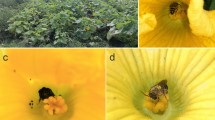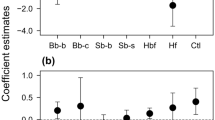Abstract
Pollen deposition, a surrogate for bee efficiency, becomes increasingly important during their interspecific interactions. We conducted field experiments on highly cross-pollinated melon (Cucumis melo) and watermelon (Citrullus lanatus) in order to understand how bee species with different pollination efficiencies displace each other from floral resources. We observed significant displacement of less abundant but more efficient bees by the more abundant but less efficient bees in both crops, which may lead to deficient pollination. We did not find significant relationship of the bee displacement success and body size or abundance. Apis florea (Fabricius) and Nomia sp.2 (Latreille) had significantly more winner events in melon, while the former also had significantly more winner events in watermelon. A. florea was the only bee species that foraged mostly within the 1-m2 virtual area after their displacement, which may indicate its behavior of geitinogamous pollination. The two bee species, Ceratina sexmaculata (Smith) and Lasioglossum sp. (Curtis), were more sensitive to displacement as their proportion of leaving the 1-m2 virtual area was higher.


Similar content being viewed by others
References
Adler LS, Irwin RE (2006) Comparison of pollen transfer dynamics by multiple floral visitors: experiments with pollen and fluorescent dye. Ann Bot 97:141–150
Aizen M, Feinsinger P (1994) Habitat fragmentation, native insect pollinators, and feral honey bees in Argentina “Chaco Serrano”. Ecol Appl 4:378–392
Albrecht M, Gotelli NK (2001) Spatial and temporal niche partitioning in grassland ants. Oecologia 126(1):134–141
Ali M, Saeed S, Sajjad A (2011) In search of the best pollinators for canola (Brassica napus L.) production in Pakistan. Appl Entomol Zool 46:353–361
Baude M, Dajoz I, Danchin E (2008) Inadvertent social information in foraging bumblebees: effects of flower distribution and implications for pollination. Anim Behav 76:1863–1873
Baude M, Danchin E, Mugabo M, Dajoz I (2011) Conspecifics as informers and competitors: an experimental study in foraging bumble-bees. Proc R Soc B 278:2806–2813
Bosch J, Vicens N (2006) Relationship between body size, provisioning rate, longevity and reproductive success in females of the solitary bee Osmia cornuta. Behav Ecol Sociobiol 60(1):26–33
Butz Huryn VM (1997) Ecological impacts of introduced honey bees. Q Rev Biol 2:275–297
Canto-Aguilar MA, Parra-Tabla V (2000) Importance of conserving alternative pollinators: assessing the pollination efficiency of the squash bee, Peponapis limitaris in Cucurbita moschata (Cucurbitaceae). J Insect Conserv 4:203–210
Coffey MF, Breen J (1997) Seasonal variation in pollen and nectar resources of honey bees in Ireland. J Apicult Res 36:63–76
Dafni A (1992) Pollination ecology: a practical approach. Oxford University Press, New York, p 250
Fenster CB, Armbruster WS, Wilson P, Dudash MR, Thomson JD (2004) Pollination syndromes and floral specialization. Annu Rev Ecol Evol Syst 35:375–403
Fontaine C, Dajoz I, Meriguet J, Loreau M (2006) Functional diversity of plant–pollinator interaction webs enhances the persistence of plant communities. PLoS Biol 4:129–135
Garibaldi LA, Steffan-Dewenter I, Winfree R, Aizen MA, Bommarco R, Cunningham SA et al (2013) Wild pollinators enhance fruit set of crops regardless of honey bee abundance. Science 339:1608–1611
Gawleta N, Zimmermann Y, Eltz T (2005) Repellent foraging scent recognition across bee families. Apidologie 36:325–330
Gotelli NJ, Entsminger GL (2007) EcoSim: null models software for ecology. Version7. Acquired Intelligence Inc. & Kesey-Bear. Jericho, VT 05465. http://garyentsminger.com/ecosim.htm. Accessed 12 Sep 2013
Goulson D, Sparrow KR (2009) Evidence for competition between honeybees and bumblebees; effects on bumblebee worker size. J Insect Conserv 13:177–181
Greenleaf SS, Kremen C (2006) Wild bees enhance honey bees’ pollination of hybrid Sunflower. Proc Natl Acad Sci U S A 103(37):890–895
Heard TA (1994) Behavior and pollinator efficiency of stingless bees and honey-bees on macadamia flowers. J Appl Res 33:191–198
Inouye D (1978) Resource partitioning in bumblebees-experimental studies of foraging behavior. Ecology 59:672–678
Johnson LK (1983) Foraging strategies and the structure of stingless bee communities in Costa Rica. Social insects in the tropics. In: Proc. 1st Int. Symp. I.U.S.S.I and Soc. Mex. Entomol., Cocoyoc, Morelos, Mexico, pp 31–58
Kajobe R, Echazarreta CM (2005) Temporal resource partitioning and climatological influences on colony flight and foraging of stingless bees (Apidae; Meliponini) in Ugandan tropical forests. Afr J Ecol 43:267–275
Kaminski AC, Absy ML (2006) Bees visitors of three species of Clusia (Clusiaceae) flowers in Central Amazonia. Acta Amaz 36:259–264
Kawaguchi LG, Ohashi K, Toquenaga Y (2006) Do bumble bees save time when choosing novel flowers by following conspecifics? Funct Ecol 20:239–244
Khan SU, Hassan M, Khan FK, Bari A (2010) Climate classification of Pakistan. Balwois Conference: Republic of Macedonia. 1–47
Klein AM, Vaissiere BE, Cane JH, Steffan-Dewenter I, Cunningham SA, Kremen C, Tscharntke T (2007) Importance of pollinators in changing landscapes for world crops. Proc R Soc Lond B 274:303–313
Kremen C, Williams NM, Thorp RW (2002) Crop pollination from native bees at risk from agricultural intensification. Proc Natl Acad Sci U S A 99:16812–16816
Lichtenberg EM, Imperatriz-Fonseca VL, Nieh JC (2010) Behavioral suites mediate group-level foraging dynamics in communities of tropical stingless bees. Insect Soc 57:105–113
Liowet LH, Sodhi NS, Elmqvist T (2001) Bee diversity along a disturbance gradient in tropical lowland forests of South-east Asia. J Appl Ecol 38:180–192
Michener CD (2000) The bees of the world. John Hopkins University Press, Baltimore p 304–808
Nagamitsu T, Inoue T (1997) Aggressive foraging of social bees as a mechanism of floral resource partitioning in an Asian tropical rainforest. Oecologia 110:432–439
Ne’eman G, Jurgens A, Newstrom-Lloyd L, Potts SG, Dafni A (2010) A framework for comparing pollinator performance: effectiveness and efficiency. Biol Rev 85:435–451
Nieh JC, Kruizing AK, Barreto LS, Contrera FAL, Imperatrizfonseca VL (2005) Effect of group size on the aggression strategy of an extirpating stingless bee, Trigona spinipes. Insect Soc 52:147–154
Niemirski R, Zych M (2011) Fly pollination of dichogamous Angelica sylvestris (Apiaceae): how (functionally) specialized can a (morphologically) generalized plant be? Plant Syst Evol 294:147–158
Ollerton J, Price V, Armbruster WS, Memmott J, Watts S, Waser NW, Totland Ø, Goulson D, Alarcon R, Staout SC, Tarrant S (2012) Overplaying the role of honey bees as pollinators: a comment on Aebi and Naumann. Trends Ecol Evol 27:141–142
Osorio-Berinstain M, Dominguez C, Eguiarte L, Benrey B (1997) Pollination efficiency of native and invading Africanized bees in the tropical dry forest annual plant, Kallstroemia grandiflora Torr ex Gray. Apidologie 28:11–16
Pianka ER (1973) The structure of lizard communities. Annu Rev Ecol Syst 4:53–74
Pinkus-Rendon M, Parra-Tabla V, Melendez-Ramirez V (2005) Floral resource use and interactions between Apis mellifera and native bees in cucurbit crops in Yucatan, Mexico. Can Entomol 137:441–449
Potts S, Vulliamy B, Dafni A, Ne’eman G, Willmer P (2003) Linking bees and flowers: how do floral communities structure pollinator communities? Ecology 84:2628–2642
Raine NE, Chittka L (2007) Flower constancy and memory dynamics in bumblebees (Hymenoptera: Apidae). Entomol Gen 29:179–199
Reader Z, Macleod I, Elliot PT, Robinson OJ, Manica A (2005) Inter order interactions between flower-visiting insects: foraging bees avoid flowers previously visited by hoverflies. J Insect Behav 18:51–57
Rogers RS, Cajamarca P, Tarpy DR, Burrack JH (2013) Honey bees and bumble bees respond differently to inter and intra-specific encounters. Apidologie 44:621–629
Roubik DW (1982) Ecological impact of Africanized honeybees on native neotropical pollinators. In: Jaisson P (ed) Social insects in the tropics. Universite Paris-Nord, Paris, pp 233–247
Roubik DW, Moreno JE, Vergara C, Wittmann D (1986) Sporadic food competition with the African honey bee: projected impact on neotropical social bees. J Trop Ecol 2:97–111
Saeed S, Malik SA, Dad K, Sajjad A, Ali M (2012) In search of the best native pollinators for bitter gourd (Momordica charantia L.) pollination in Multan, Pakistan. Pak J Zool 44(6):1633–1641
Sahli HF, Conner JK (2007) Visitation, effectiveness, and efficiency of 15 genera of visitors to wild radish, Raphanus raphanistrum (Brassicaceae). Am J Bot 94:203–209
Sampson BJ, Knight PR, Cane JH, Spiers JM (2007) Foraging behavior, pollinator effectiveness, and management potential of the new world squash bees Peponapis pruinosa and Xenoglossa strenua (Apidae: Eucerini). Hort Sci 42:459–459
Slaa EJ, Wassenberg J, Biesmeijer JC (2003) The use of field-based social information in eusocial foragers: local enhancement among nestmates and heterospecifics in stingless bees. Ecol Entomol 28:369–379
Stanghellini MS, Ambrose JT, Schultheis JR (1997) The effects of honey bee and bumble bee pollination on fruit set and abortion of cucumber and watermelon. Am Bee J 137:386–391
Steffan-Dewenter I, Westphal C (2008) The interplay of pollinator diversity, pollination services and landscape change. J Appl Ecol 45(3):737–741
Stout JC, Goulson D (2001) The use of conspecific and interspecific scent marks by foraging bumblebees and honeybees. Anim Behav 62:183–189
Sudgen EA, Thorp R, Buchmann S (1996) Honey bee-native bee competition: focal point for environmental change and apicultural response in Australia. Bee World 77:26–44
Tan NQ (2008) Pollinatin ecology of Melaleuca cajuputi, Nypa fruticans and their flower visitors. J Apicult Res 47:10–16
Thomson JD, Goodell K (2001) Pollen removal and deposition by honeybee and bumblebee visitors to apple and almond flowers. J Appl Ecol 38:1032–1044
Acknowledgments
We are grateful to Dr. Alain Pauly (Department of Entomology, Royal Belgian Institute of Natural Sciences, Brussels) for his help with identification of Nomia sp. The study was funded by the Higher Education Commission of Pakistan.
Author information
Authors and Affiliations
Corresponding author
Additional information
Edited by Fernando B Noll – UNESP
Rights and permissions
About this article
Cite this article
Ali, M., Saeed, S., Sajjad, A. et al. Linking Pollination Effectiveness and Interspecific Displacement Success in Bees. Neotrop Entomol 44, 101–108 (2015). https://doi.org/10.1007/s13744-014-0259-0
Received:
Accepted:
Published:
Issue Date:
DOI: https://doi.org/10.1007/s13744-014-0259-0




